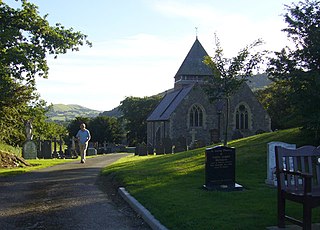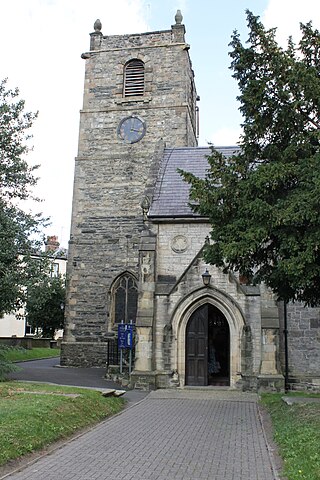
Powis Castle is a medieval castle, fortress and grand country house near Welshpool, in Powys, Wales. The seat of the Herbert family, earls of Powis, the castle is known for its formal gardens and for its interiors, the former having been described as "the most important", and the latter "the most magnificent", in the country. The castle and gardens are under the care of the National Trust. Powis Castle is a Grade I listed building, while its gardens have their own Grade I listing on the Cadw/ICOMOS Register of Parks and Gardens of Special Historic Interest in Wales.

Llandinam is a village and community in Montgomeryshire, Powys, central Wales, between Newtown and Llanidloes, located on the A470. As a community, Llandinam is made up of the village itself, small hamlets including Plas Dinam and Little London and several farms. The village itself has a population of around 576 with 56% born in Wales.
Berriew is a village and community in Montgomeryshire, Powys, Wales. It is on the Montgomeryshire Canal and the Afon Rhiw, near the confluence with the River Severn at grid reference SJ185005, 79 miles (128 km) from Cardiff and 151 miles (243 km) from London. The village itself had a population of 283. and the community also includes Garthmyl Hall and Refail.

Three Cocks or Aberllynfi is a village near Glasbury in Powys, Wales. The Welsh name refers to the mouth of the Afon Llynfi which enters the River Wye a mile from the village. The nearest town is Hay-on-Wye some 5 miles (8.5 km) to the northeast.

Llanfyllin is a market town and community in Powys, Wales. The community population in 2021 was 1,586 and the town's name means church or parish (llan) of St Myllin. The community includes the settlements of Bodfach, Ty Crwyn, Abernaint and several farms.

Hay Castle is a medieval fortification and 17th-century mansion house in the small town of Hay-on-Wye in Powys, Wales. Originally constructed as part of the Norman invasion of Wales, the castle was designed as a ringwork overlooking the town in either the late 11th or the early 12th centuries. It was rebuilt in stone around 1200 by the de Braose family and then had a turbulent history, being attacked and burnt several times during the First and Second Barons' Wars, the wars with the Welsh princes, the rebellion of Owain Glyndŵr and the Wars of the Roses. In the 17th century a Jacobean mansion house was built alongside the medieval keep and the property became a private home. Serious fires in 1939 and 1977 gutted the castle and, despite repairs in the 1980s, by the early 21st century much of the building was derelict and unstable. Since 2011 it has been owned by Hay Castle Trust who have restored the property to form a centre for arts, literature and learning. Following the restoration, partly funded by grants from the National Lottery Heritage Fund of over £5m, the castle opened to the public on 26 May 2022.
Glasbury, also known as Glasbury-on-Wye, is a village and community in Powys, Wales. The village lies at an important crossing point on the River Wye, connecting the historic counties of Brecknockshire and Radnorshire, and is located just outside the Brecon Beacons National Park, north of the Black Mountains. The village is split between the communities of Glasbury and Gwernyfed. The nearest town is Hay-on-Wye, some 4 miles (6 km) to the north east. The nearest city is Hereford in England, some 25 miles (40 km) to the east. Glasbury is a popular location for river fishing, canoeing and kayaking. The population of Glasbury community in Radnorshire was 994, in 1841 it was 838.

Maesyronnen Chapel is about 1 mile (2 km) north of the village of Glasbury, Powys, Wales. It is designated by Cadw as a Grade I listed building. The chapel is one of the earliest Nonconformist chapels to be built in Wales, and is the only chapel existing from that time to be largely unchanged and still in use as a chapel. It is currently administered by the United Reformed Church. The attached ccaretaker's cottage is also listed at Grade I.
Baynham Hall is a Grade II* listed 17th -century manor house located in Michaelchurch-On-Arrow, Gladestry, Powys, Wales.

The Royal House in Machynlleth is a 16th-century merchant’s house with extensive interior timber framing, clad in stone on the outside, with two massive chimney stacks. The building has been dated by dendrochronology, or tree-ring dating, giving felling dates for timbers within the house of 1559–1561, and for the rear store-house range of 1576. The building was acquired by the Machynlleth Tabernacle Trust and excavations and survey were undertaken by CPAT before restoration work was started in 2005. The restoration was supported by the Heritage Lottery funding.

Penoyre House, Battle, Powys, Wales is a nineteenth century country house. Designed by Anthony Salvin for Colonel John Lloyd Vaughan Watkins, it was built between 1846-8. In an Italianate style, it is described by Mark Girouard as "Salvin's most ambitious classical house". The enormous cost of the house almost bankrupted the family and it was sold only 3 years after Colonel Watkins's death. From 1947, the house was in institutional use, and was converted to apartments in the early twenty-first century. The building is Grade II* listed The gardens are listed Grade II on the Cadw/ICOMOS Register of Parks and Gardens of Special Historic Interest in Wales.

The Church of St Issui, Partrishow, Powys, Wales, is a Grade I listed parish church dating from 1060. The existing building was mainly constructed in the 14th and 15th centuries and was sensitively restored in 1908–1909. The church is most famous for its rood screen which dates from 1500. It is a Grade I listed building.

The Bear Hotel, formerly the White Bear, stands on Beaufort Street, Crickhowell, Powys, Wales. A coaching inn from the mid 18th century, the building has older origins from the 17th and 15th centuries. It is a Grade II* listed building.

The Church of St Anno in Llananno, Powys, Wales, is a redundant church dating from the 14th century. Its medieval rood screen is considered "one of the great treasures of Welsh craftsmanship". A Grade II* listed building, the church is now in the care of the Friends of Friendless Churches.

Llandrinio Bridge, Llandrinio, Powys, Wales, is a road bridge over the River Severn. Constructed between 1769 and 1775, the bridge is attributed to John Gwynn of Shrewsbury, a noted local architect who designed a number of crossings over the Severn, as well as Magdalen Bridge in Oxford. The bridge is also the site of defensive structures dating to World War II, including a pillbox disguised as an agricultural cowshed and Dragon's teeth tank traps at its northern end. The bridge is a Grade I listed structure and a Scheduled monument.

St Collen's Church is a parish church in the town of Llangollen, Denbighshire, Wales. The first church on the site was founded by Collen in the 6th century. Nothing of this building remains. A new church was built in the 13th century, in the Early English Gothic style. This was developed in the succeeding centuries, and then almost completely rebuilt in the 19th century. The architect of the Victorian reconstruction was Samuel Pountney Smith, who retained little of the earlier church, with the exception of the tower. The churchyard contains the grave of the Ladies of Llangollen, Eleanor Charlotte Butler and Sarah Ponsonby, and their servant Mary Carryl, who lived at the nearby Plas Newydd. In November 2021 the first blessing of a gay partnership in a Church in Wales church was held at St Collen's. The church is an active parish church in the Diocese of St Asaph. It is designated by Cadw as a Grade I listed building.

The Straining Tower at Lake Vyrnwy is an intake tower built to extract water from the lake. The tower stands on the north shore of Lake Vyrnwy, near the village of Llanwddyn, in Powys, Wales. The Lake Vyrnwy dam project was designed to provide a water supply to the city of Liverpool and work on the dam began in 1881. On its completion 11 years later, the lake was the largest reservoir in Europe and water was drawn from it into the straining tower and carried to Liverpool on a 110km-long aqueduct. The engineers for the project were Thomas Hawksley and George Frederick Deacon, although the straining tower was entirely Deacon's design. The tower is constructed in a Gothic Revival style, purportedly based on the tower of the castle at Chillon, Switzerland. It draws heavily on the contemporaneous work of William Burges, whose Cardiff Castle and Castell Coch are clear influences. The straining tower is a Grade I listed building.

The farm at Great Porthamel, at Talgarth in Powys, Wales, comprises a range of buildings including the farmhouse, the gate tower and an agricultural building. They form the remnants of a major medieval manor that was the principal seat of the Vaughan family. The complex has been described as "one of the more remarkable mediaeval houses of Wales". The gatehouse is a Grade I listed building, and a scheduled monument, while the farmhouse is listed at Grade II* and the agricultural building at Grade II.

Harpton Court, Old Radnor, Powys, is a Tudor Revival house dating from the late 19th century. It originally formed the north-west wing to a much larger Neoclassical mansion, which was reconstructed by John Nash in the early 19th century, but the main part of the court was demolished in 1956. The house was the ancestral home of the Lewis family, whose most prominent member, George Cornewall Lewis, served as Chancellor of the Exchequer and Home Secretary under Lord Palmerston. The court remains a private house and is a Grade II listed building. Its gardens and grounds are listed on the Cadw/ICOMOS Register of Parks and Gardens of Special Historic Interest in Wales.

Old Gwernyfed is a house dating from the medieval period in the community of Gwernyfed, Powys, Wales, close to the village of Felindre. It remains a private home and is a Grade I listed building. The gardens are listed on the Cadw/ICOMOS Register of Parks and Gardens of Special Historic Interest in Wales.


















